These NCERT Solutions for Class 7 Science Chapter 12 Reproduction in Plants Questions and Answers are prepared by our highly skilled subject experts to help students while preparing for their exams.
Reproduction in Plants NCERT Solutions for Class 7 Science Chapter 12
Class 7 Science Chapter 12 Reproduction in Plants Textbook Exercise Questions and Answers
Question 1.
Fill in the blanks:
a. Production of new individuals from the vegetative part of parent is called ………………
b. A flower may have either male or female reproductive parts. Such a flower is called ………………
c. The transfer of pollen grains from the anther to the stigma of the same or of another flower of the same kind is known as ………………
d. The fusion of male and female gametes is termed as ………………
e. Seed dispersal takes place by means of ………………, ……………… and ………………
Answer:
a. vegetative propagation
b. unisexual flower
c. pollination
d. fertilisation
e. wind, water, animals
Question 2.
Describe the different methods of asexual reproduction. Give examples.
Answer:
There are following methods of asexual reproduction:
a. Vegetative propagation: In this asexual reproduction, new plants are produced from roots, stems, leaves and buds of individual plant. For example: stem cutting in champa, eye growth in potatoes, leaf bud in case of Bryophyllum, etc.
b. Budding: The bud is a small projection which gradually grows and gets detached from the parent cell and forms a new cell. The new cell grows, matures and produces more cells. For example, in yeast and Hydra.
c. Fragmentation: In this mode of reproduction, the growth and multiplication is done by rapidly breaking down into two or more fragments. Each piece grows into new individual when water and nutrients are available. For example, algae.
d. Spore formation: This reproduction is done by spores, which germinate under favourable conditions and develop into a new individual. For examples, mosses and ferns.
Question 3.
Explain what you understand by sexual reproduction.
Answer:
When two parents are involved in reproduction, it is called sexual reproduction. Formation of male and female gametes is the first step of sexual reproduction. The male and female gametes fuse during fertilisation to produce zygote. The zygote subsequently develops into an embryo which further develops into a new individual.
Question 4.
State the main differences between asexual and sexual reproduction.
Answer:
| Asexual Reproduction |
Sexual Reproduction |
| 1. One parent is involved. | 1. Two parents are involved. |
| 2. New generation is identical or true copy of their parent. | 2. New born are similar to their parents with some variations. |
| 3. It doesn’t require the formation of gametes. | 3. It requires the formation of gametes. |
| 4. Special organs for reproduction are not required. | 4. Special organs for reproduction are required. |
| 5. Examples: Potato, Jasmine, Rose, Yeast, Bryophyllum, etc. | 5. Examples: Mangoes, coconut, Hibiscus, etc. |
![]()
Question 5.
Sketch the reproductive parts of a flower.
Answer:
Stamen is the male while pistil is the female reproductive part of a flower.
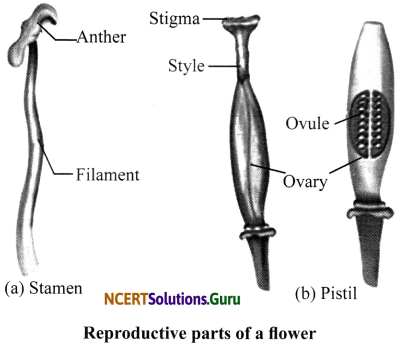
Question 6.
Explain the difference between self-pollination and cross-pollination.
Answer:
| Self pollination | Cross Pollination |
| 1. It is the transfer of pollen grains from the stamen to the pistil of the same flower or another flower of the same plant. | 1. It is the transfer of pollen grains from the stamen of one flower to the pistil of another flower of different plants of the same kind. |
| 2. External medium is not required. | 2. External medium is required. |
| 3. It occurs only in bisexual flowers. | 3. It occurs in both unisexual and bisexual flowers. |
Question 7.
How does the process of fertilisation take place in flowers?
Answer:
When ripe pollen from an anther lands on the stigma of the same kind of flower, each pollen grain sends out a tiny thread-like tube. The tube grows down through the style and pierces one of the ovules in the ovary. This pollen tube carries a male gamete to meet the female gamete in the ovule. Two gametes fuse together to form zygote. The process of fusion of male and female gametes (to form a zygote) is called fertilisation. The zygote develops into an embryo.
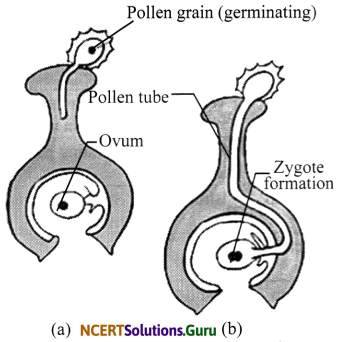
Question 8.
Describe the various ways by which seeds are dispersed.
Answer:
Following are the various methods of seed dispersal:
a. Dispersal by Wind: Seeds of some plants are light-weight or have hair-like or wing-like structures present on them. Such seeds float in air and are thus dispersed by wind. For example: Dandelion, maple, drumstick, etc.
b. Dispersal by Water: Dispersal by water takes place in some aquatic plants and in some which grow near a water body. Seeds of water lily float and thus are dispersed by water. The coconut seed has a tough fibrous covering which has plenty of air inside. This helps the coconut seeds in floating on water.
c. Dispersal by Animals: Some seeds have spine-like structures on them. They get stuck to the fur of animals and thus get spread to different places. For example: Beggar tick, Xanthium, Urena, etc. Some seeds are swallowed by birds and animals along with fruits. These seeds get dispersed with bird or animal droppings.
d. Dispersal by Bursting: Some fruits burst open when they mature. The force of bursting is enough to spread the seeds. For example: ladyfinger, castor, balsam, etc.
e. Dispersal by Humans: Human beings also help in dispersal of seeds, especially during farming.
![]()
Question 9.
Match the items in column I with those of column II
| Column I |
Column II |
| 1. Bud | (a) Maple |
| 2. Eyes | (b) Spirogyra |
| 3. Fragmentation | (c) Yeast |
| 4. Wings | (d) Bread mould |
| 5. Spores | (e) Potato |
| (f) Rose |
Answer:
1. (c),
2. (e),
3. (b),
4. (a),
5. (d)
Question 10.
Tick the correct answer:
a. The reproductive part of a plant is the
(i) leaf
(ii) stem
(iii) root
(iv) flower
Answer:
(iv) flower
b. The process of fusion of the male and the female gametes is called
(i) fertilisation
(ii) pollination
(iii) reproduction
(iv) seed formation
Answer:
(i) fertilisation
c. Mature ovary forms the
(i) seed
(ii) stamen
(iii) pistil
(iv) fruit
Answer:
(iv) fruit
d. A spore producing plant is
(i) rose
(ii) bread mould
(iii) potato
(iv) ginger
Answer:
(ii) bread mould
e. Bryophyllum can reproduce by its
(i) stem
(ii) leaves
(iii) roots
(iv) flower
Answer:
(ii) leaves
NCERT Extended Learning Activities and Projects
Question 1.
Make your own garden by collecting pieces cut from different kinds of cacti. Grow the variety in one single flat container or in separate pots.
Hint:
Cactus can grow in scarcity of water and can withstand the absence of water for a long time. That is why, it can grow easily in the deserts. Thus, cactus can be grown quite easily in pots in home in single container or in separate pots.
Question 2.
Visit a fruit market and collect as many local fruits as possible. If many fruits are not available, you can collect tomatoes and cucumber (these are fruits, though we use them as vegetables). Make drawings of the different fruits. Split the fruits and examine the seeds within. Look for any special characteristics in the fruit and their seeds. You can visit a library also to learn about this.
Hint:
Collect the fruits and study the characteristics of fruits and seeds on your own.
![]()
Question 3.
Think of ten different fruit-bearing plants. Remember that many vegetables are also fruits of the plants. Discuss with your teacher, parents, farmers, fruit growers and agricultural experts (if available nearby) and find out the manner of their dispersal. Present your data in the form of a table as shown below.
| S. No. | Name of fruit bearing plant | Agent through which seeds are dispersed | Part of seed which helps in dispersal |
| 1. | |||
| 2. | |||
| 3. |
Hint:
| S. No. | Name of fruit bearing plant | Agent through which seeds are dispersed | Part of seed which helps in dispersal |
| 1. | Coconut | Water | Fibrous coating |
| 2. | Lotus | Water | Thalamus which floats in water |
| 3. | Balsam | Sudden jerk | Bursting pericarp |
| 4. | Banyan | Birds | Stick to the beak of birds |
| 5. | Orchid | Wind | Lightness, minutes |
| 6. | Cotton | Wind | Hair on seeds |
| 7. | Silk | Wind | Hair on seeds |
| 8. | Tecoma | Wind | Winged seeds |
| 9. | Oxalis | Animals | Barbs/hooks |
| 10. | Tiger’s nail | Animals | Seeds have hooks |
Question 4.
Suppose there is one member of a particular kind of organism in a culture dish, which doubles itself in one hour through asexual reproduction. Work out the number of members of that kind of organism which will be present in the culture dish after ten hours. Such a colony of individuals arising from one parent is called a “clone”.
Hint:
The answer will be 210, i.e., 1024. Hence, new colony will have 1024 members after 10 hours.
Activity 1
Objective: To observe tuber of a potato and grow new plants from potato tubers.
Materials Required: A potato with buds or eyes and pot with soil in it.
Procedure:
- Plant the parts of the potato with eyes or buds in the soil.
- Water the soil regularly.
- Observe over a week.
Observation: After a week, new shoots and roots emerge out from the potato.
Conclusion: The conclusion of this activity is that the new plants can be grown from the tubers of potato.
ii. Budding: This method is used by unicellular plants like yeast. Yeast is a fungus and fungi are also known as non-green plants. The yeast cell produces a bulb-like projection coming out of the parent cell, called a bud, which gets its own nucleus. The bud develops to certain size and detaches from the mother cell to produce the new yeast cell. Sometimes another bud arises from a bud before it gets detached, forming a chain of buds.
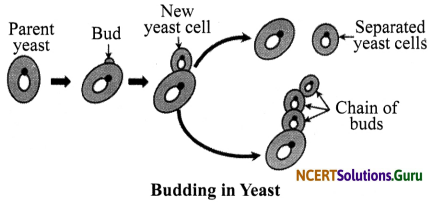
Activity 2
Objective: To observe budding in yeast.
Materials Required: A petri dish, yeast (dry), sugar solution and a magnifying glass.
Procedure:
- Add some yeast into the petri dish containing sugar solution.
- Keep it undisturbed for 30 minutes.
- Observe the yeast cells under a magnifying glass.
Observation: We can see the bubbles with foam in the petri dish.
Conclusion: Due to the budding process, the yeast cells divide and increase the volume of the solution while releasing gases.
iii. Fragmentation: Algae, likeSpirogyra, generally reproduces by the process of fragmentation in which they divide themselves into multiple parts. As soon as the plant finds enough water and nutrients, it fragments and each fragment then grows into a new individual. This process continues and algae multiply quickly in a short period of time.
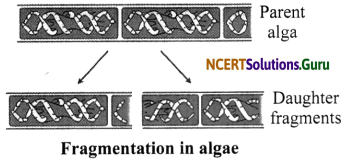
iv. Spore Formation: Spores are special asexual reproductive structures covered by a hard protective coat. They can withstand unfavourable conditions, such as high temperature, with the help of protective coat. They can germinate under favourable conditions and can develop into a new individual. Spores can float in the air and cover long distances. For example, ferns, mosses, lichens and fungi reproduce by spore formation.
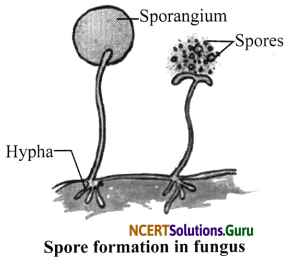
Sexual Reproduction in Flowering Plants: Flower is the reproductive part of a plant. A complete flower is made up of four whorls on it. From outside inwards, these are sepals, petals, stamens and pistil. These four whorls are attached to a flattened tip of the flower called as receptacle.
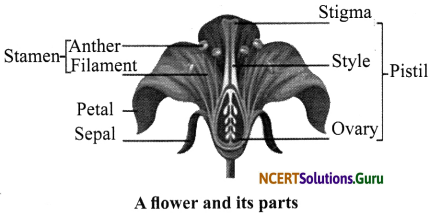
i. Sepals collectively form calyx. These are green in colour and protect the inner parts of the flower in its bud condition.
ii. Petals collectively form corolla. These are the coloured structures which attract insects and birds for pollination.
iii. Stamens are the male reproductive parts of a flower. Stamen is made up of two structures namely, a filament and an anther. Filament is a tubular structure. Anther is a knob-like structure containing pollen sacs filled with pollen grains. Pollen grains produce the male gametes or the male reproductive cells.
iv. Pistil is the centrally located female reproductive part of a flower. It is made up of stigma, style and ovary. The stigma is a flattened structure which receives the pollen grains. It is sticky in nature. The style is a long tubular structure which conveys pollen to the ovary. The ovary contains numerous ovules. Each ovule contains a female gamete or egg cell.
![]()
Activity 3
Objective: To dissect a flower and observe its reproductive parts.
Materials Required: A mustard/china rose/ petunia flower, needle, a blade and hand lens.
Procedure
- Observe the flower using a hand lens and examine the parts.
- Carefully remove its stamen and pistil.
- Study the various parts of a stamen and pistil.
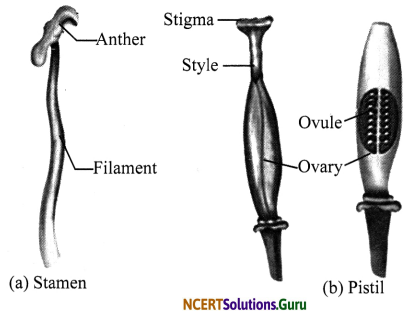
Observation: Stamen is the male reproductive part of the flower. Stamen consists of two parts anther and filament. Pistil is the female reproductive part of the flower. It is comprised of the stigma, style and the ovary.
Conclusion: Stamen and pistil are the reproductive parts of the flower.
Types of Flowers: Flowers, based on the reproductive whorls they carry, can be classified into unisexual flowers and bisexual flowers.
i. A unisexual flower is the flower which consists of either stamens or pistil. A flower with a whorl of stamens is called as male flower. A flower with just a pistil is called as a female flower. Eg., papaya, watermelon, cucumber, coconut, etc.
ii. A bisexual flower is the flower which consists of both the whorls of stamens and pistil, i.e., both male and female reproductive structures. Eg., lily, rose, brinjal, Hibiscus, Petunia, mustard, etc.
Pollination: The transfer of pollen grains from anthers to the stigma of a flower is called pollination. Pollination is of two types, viz., self pollination and cross pollination.
i. Self Pollination: If the pollens are transferred from the anthers to the stigma of the same flower, it is called self pollination.
ii. Cross Pollination: If the pollens are transferred from the anthers to the stigma of different flowers of the same plant or flowers of a different plant of the same kind, it is called cross pollination. Plants need help ftom various agents of pollination to carry out cross pollination. Wind, water, insects, birds and other animals play the role of pollination agents.

Fertilisation: When pollen settles on top of the stigma, it germinates to produce a pollen tube. The pollen tube enters the ovary through the style. Male nuclei are transferred to the ovary through the pollen tube. Inside the ovary, male gamete fuses with the egg cell present inside the ovule. The cell formed, just after fertilisation, is called zygote. Zygote develops into embryo. Each embryo develops into a seed. This process of fusion of male gamete with that of the egg nucleus is called fertilisation.
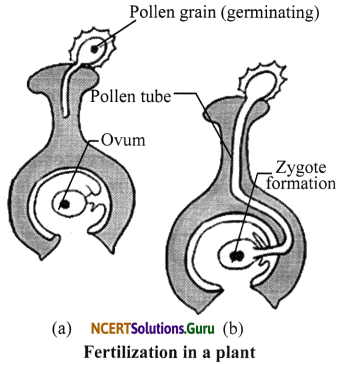
Fruits and Seeds: After fertilisation, ovary develops into fruit and ovules develop into seeds. Other flower parts fall off. The seed is an embryo enclosed in a protective coat. Some fruits are fleshy and juicy, such as mango and orange, while some are dry and hard, such as almonds and walnuts.
Dispersal of Seeds: The transportation of seeds from the parent plant to different places is called seed dispersal. Seed dispersal allows growth of the same kind of plants in different regions. This is helpful because it minimises the competition for food, sunlight, water and minerals among the plants of the same kind in the same area. It also allows them to grow in different habitats.
Seed dispersal is carried out by agencies like air, water, birds and other animals including man.
- Seeds dispersed by wind can have wings, such as in drumstick and maple, can be light-weighted as in grasses or can be hairy as in aak and sunflower (hairy fruit).
- Seeds dispersed by water have spongy or fibrous outer coat that helps in floating, such as in coconut.
- Seeds dispersed by animals are spiny and hooked so that they can get attached to the animal body and carted to different places. For example, Xanthium and Urena.
- Some seeds, such as in castor and balsam are dispersed by the bursting of fruit with sudden jerks.
Advantages of seed dispersal:
- Seed dispersal prevents competition between the plant and its own seedlings for sunlight, water and nutrients.
- Plants can acquire new habitats by seed dispersal and distribute widely.
- It avoids overcrowding of young plants around their parent plants. Overcrowding could lead to severe competition for sunlight, water, minerals and space. As a result, seedlings would not grow into healthy plants.
Class 7 Science Chapter 12 Reproduction in Plants Additional Important Questions and Answers
Very Short Answer Type Questions
Question 1.
What is meant by reproduction?
Answer:
The process of producing new individuals of the same kind of the same species is called reproduction.
Question 2.
Why is reproduction an essential life process?
Answer:
Reproduction is essential for continuation of the species from generation to generation.
Question 3.
What do you mean by vegetative propagation?
Answer:
Vegetative propagation is the ability of plants to reproduce by using vegetative parts like root, stem and leaves.
Question 4.
Define fertilisation.
Answer:
The process of fusion of male and female gametes to form a zygote is called fertilisation.
![]()
Question 5.
Define fragmentation.
Answer:
The process of asexual reproduction in which an organism breaks up into two or more fragments is called fragmentation. These fragments grow into new individuals.
Question 6.
What is meant by a unisexual flower?
Answer:
A flower having either pistil or only the stamens is called a unisexual flower.
Question 7.
What is zygote?
Answer:
The cell which results after the fusion of gametes during fertilisation is called a zygote.
Question 8.
Which pat of flower gives rise to fruit?
Answer:
After fertilisation, the ovary grows into a fruit and other parts of the flower fall off. The fruit is the ripened ovary.
Question 9.
Name the reproductive organ of a flowering plant.
Answer:
The flower is a reproductive organ of a flowering plant.
![]()
Question 10.
What is the role of pollen grains in flowering plants?
Answer:
Male gametes are produced inside pollen grains.
Question 11.
Give an example of an organism which reproduces by budding.
Answer:
Yeast.
Question 12.
How many parents are involved in asexual reproduction?
Answer:
Only one.
Question 13.
What is the benefit of colourful petals for plants?
Answer:
Colourful petals attract insects, birds and other animals. It helps in cross pollination and seed dispersal.
Question 14.
Give two examples of seeds which are dispersed by wind.
Answer:
Dandelion and maple.
Question 15.
Name the male reproductive part of the flower.
Answer:
Stamen.
![]()
Question 16.
Name the female reproductive part of the flower.
Answer:
Pistil.
Question 17.
Name the various modes of asexual reproduction in plants.
Answer:
Vegetative propagation, budding, fragmentation and spore formation.
Short Answer Type Questions
Question 1.
Explain the two types of reproduction in plants.
Answer:
The two types of reproduction in plants are:
a. Asexual reproduction: plants give rise to new plants without the formation of seeds. The reproductive organs are not required. New plants grow by means of:
- vegetative propagation,
- budding,
- fragmentation, or
- spore formation.
b. Sexual reproduction: In this, new plants are produced through the formation of seeds. Male and female gametes fuse to form a zygote which later on develops into a seed. For example: Petunia and mango.
Question 2.
How plants such as mosses and ferns reproduce?
Answer:
Plants such as mosses and ferns reproduce by means of spores. Spores are asexual reproductive bodies. Each spore is covered by a hard protective coat to withstand unfavourable conditions such as high temperature and low humidity. Hence, spores can survive for a long time. Under favourable conditions, a spore germinates and develops into a new individual.
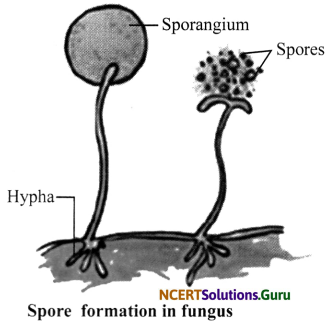
Question 3.
How does reproduction take place in yeast cells?
Answer:
Yeast is a single-celled organism. The small bulb-like projection coming out from the yeast cell is called a bud. The bud gradually grows and gets detached from the parent cell and forms a new yeast cell. The new yeast cell grows, matures and produces more yeast cells. Sometimes, another bud arises from the bud forming a chain of buds. If this process continues, a large number of yeast cells are produced in a short time.
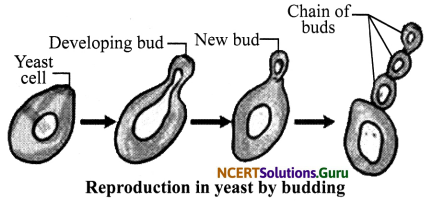
Question 4.
Write the advantages of vegetative propagation.
Answer:
- New plants can be produced quickly.
- The plants so produced are exact copies of parent plants.
- Seedless plants can be easily propagated.
![]()
Question 5.
What types of seeds are dispersed by animals?
Answer:
Some seeds are dispersed by animals, especially spiny seeds with hooks which get attached to the bodies of animals and are carried to distant places. Examples are Xanthium and Urena.
Question 6.
How do potatoes reproduce?
Answer:
Potatoes can be grown asexually by vegetative reproduction. This can be done by planting a part of potato with an eye into the soil and watering it regularly for a few days. The new stem starts arising on the eyes of the potato and a potato plant will develop.
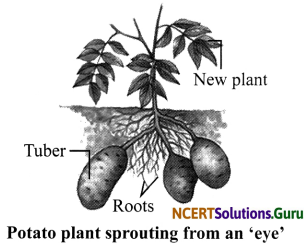
Question 7.
How do algae reproduce?
Answer:
Slimy green patches seen in ponds or in other stagnant water bodies are the algae. When water and nutrients are available, algae grow and multiply rapidly by fragmentation. An alga breaks up into two or more fragments. These fragments or pieces grow into new individuals. This process continues and they cover a large area in a short period of time.
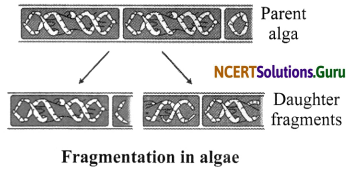
Question 8.
What is the difference between cutting and grafting?
Answer:
Cutting is a process in which a piece of vegetative part (root, stem or leaf) of a plant is selected and is rooted in the soil whereas grafting is practised in those plants which do not produced roots readily. In this process, cutting of a plant is attached to the piece of another rooted plant. The cutting is called a scion while the rooted plant is called a stock.
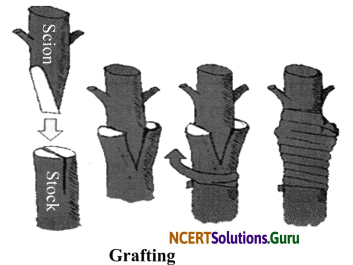
Question 9.
What are fruits? What are fleshy and dry fruits?
Answer:
Ripened ovary after fertilisation is called fruit. There are two types of fruits:
- Fleshy fruits: The fruits which are fleshy and juicy like mango, apple and orange are called fleshy fruits.
- Dry fruits: The hard and dry fruits like almonds and walnuts are called dry fruits.
![]()
Long Answer Type Questions
Question 1.
What is pollination? Explain various types of pollination.
Answer:
Pollination: The transfer of pollen grains from anthers to the stigma of a flower is called pollination. There are following two types of pollination:
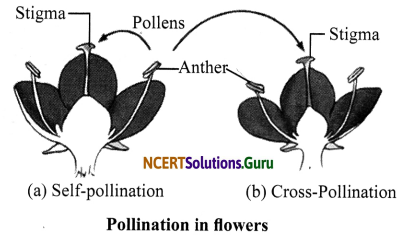
a. Self Pollination: When pollen gains are transferred from the anthers of a flower to the stigma of the same flower or another flower of the same plant, it is called self pollination.
b. Cross Pollination: When pollen grains from the anthers of a flower are transferred to the stigma, of the flowers on different plants, it is called cross pollination. Cross pollination is the norm in most of the plants. Plants need help from various agents of pollination to carry out cross pollination. Wind, water, insects, birds and other animals play the role of agents of pollination.
Question 2.
Describe the structure of a typical flower.
Answer:
Flowers are the reproductive parts of the plant. A typical flower consists of the following parts:
a. Sepals: These are green leaf like structures which help in the preparation of food.
b. Petals: These are coloured big leaf-like structures in the flower which help in the pollination.
c. Stamens: Stamens are the male reproductive parts of the flowers. There are two parts of each stamen: (i) anther and (ii) filament. Anther contains pollen grains which have male gametes.
d. Pistil: Pistil is the female reproductive part of the flowers. There are three main parts of a pistil: (i) stigma, (ii) style and (iii) ovary. The ovary contains one or more ovules. The female gametes or the eggs are formed in an ovule.
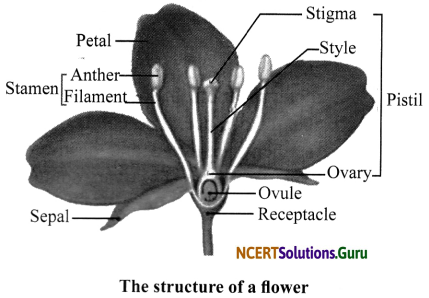
Question 3.
How the male gamete in the pollen grain reaches the female gamete present in the ovule?
Answer:
Generally, pollen grains have a tough protective coat which prevents them from drying up. Since pollen grains are light, they can be carried by wind or water. Insects visit flowers and carry along pollen on their bodies. Some of the pollens land on the stigma of a flower of the same kind. Pollen grains on the stigma grow a tiny tube, all the way down the style to the ovary. This pollen tube carries a male gamete to meet a female gamete in an ovule.
![]()
Question 4.
Describe various steps involved in the formation of a plant seed starting from pollination.
Answer:
The transfer of pollen grains from another to the stigma of a flower is called pollination. Now the male gamete enters into the ovary where fusion of male and female gametes takes place. This process is called fertilisation.
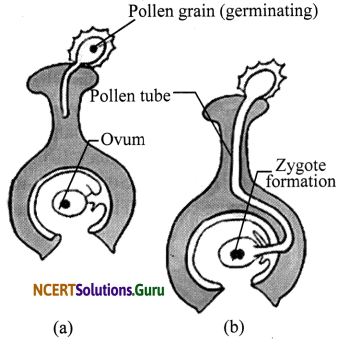
After fertilisation of ovules, various changes take place. The petals, sepals and stamens are dried and destroyed. Only ovary remains. The ovary contains fertilised ovule. After fertilisation, ovary containing a number of fertilised ovules is called fruit. The fertilised and developed ovule is called seed.
Picture-Based Questions
Question 1.
Draw a diagram to show:
a. Cross-pollination
b. Self-pollination
Answer:
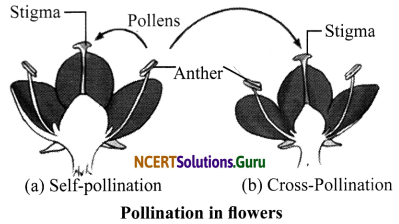
Question 2.
a. Identify the following fruits (i) and (ii).
b. Which of these is a fleshy fruit?
c. Which of these is a dry fruit?
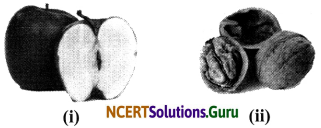
Answer:
a. (i) Apple, (ii) Walnuts
b. Apple
c. Walnut
![]()
Question 3.
Draw a diagram to show reproduction in fungus by spore formation. Label the following parts: hypha, sporangium and spores.
Answer:
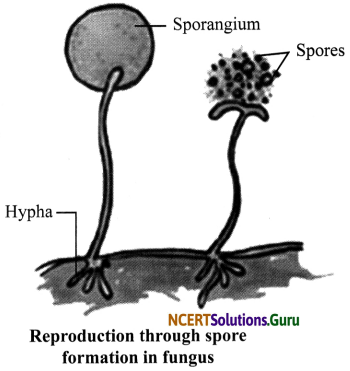
Question 4.
Observe the following figure. Identify it and write how its dispersal take place.
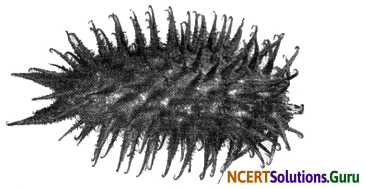
Answer:
It is a seed of Xanthium. Seeds of Xanthium have numerous spines on them which get attached to the fur of animals. Hence, these are dispersal by animals.